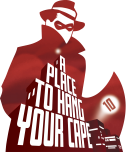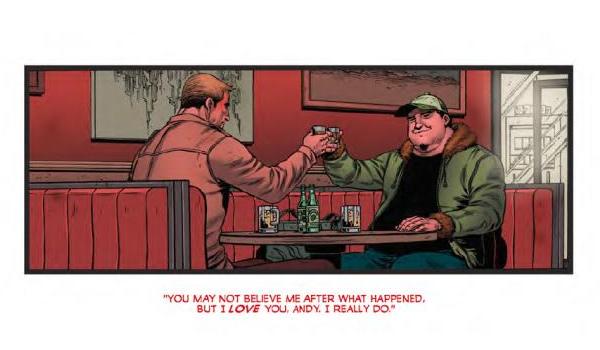We recently had a chance to catch up with Glenn Moane, creator of The Glory, a fantastic one shot I recently reviewed for A Place To Hang Your Cape. Impressed by his style and storytelling ability, we decided to get to know the man behind The Glory and find out what’s in store for the future. Here is what he had to say.
AP2HYC: The Glory is to date the first and only comic of yours that I have read. Having loved The Glory, which comic/series of yours would you suggest new fans and I read next?
Moane: First off, I’m glad you liked the comic and I appreciate you spreading the word about it. To this date there are a handful of one-shots and short stories out there with my name on them, as well as a graphic novel. The latter is titled Partners and is a crime noir story illustrated by Elias Martins. It was published by SST about a year ago as a really nice hardcover, so if readers would like to read something by me that goes on for a little longer I’d tell them to seek that book out.
Of the short stories I’ve written I like how “As a family” turned out (illustrated by Tomasz Witas, published in the anthology Out of the Blue: A Collection of Strange Stories) and my stories about the stretch doll Stretcho Savage in Brett Uren’s Torsobear volumes were a lot of fun to work on.
AP2HYC: What is the piece of work you are most proud of and why?
Moane: Well, I’m real fond of The Glory as when I wrote it I wasn’t really sure if I could make it work. It is a “talking heads” comic after all, and as much as I love reading those I initially had some doubts about being able to pull one off myself. So I put in a lot of time in order to make it the best story it could be, and when the pages from Tirso Llaneta started to come in I knew at least that the comic was going to look really good.
I’m also working on another project with Tirso right now, and by the time it’s out I suspect I’ll look at it as the best thing I’ve ever had my hands on.
AP2HYC: Do you find the concept of a “One Shot” liberating or rather confining?
Moane: It depends. None of the one-shots I’ve created set the entertainment world on fire in any way, but to me it was very satisfying to write self-contained stories that didn’t exceed 48 pages. As a writer starting out it’s easier (and less expensive!) to manage the production of a one-shot or a short story as opposed to a graphic novel or a mini-series. If nothing else, a book like The Glory functions as a decent sample of what kind of writer I am and the themes and situations I’m interested in, sort of like an EP in music industry terms.
But like most of the writers out there I’d like to take a shot at a few long form projects as well. And since many of the artists I work with can only commit to a certain amount of pages in their schedule, it made me think of how I could approach such a project when it came to one-shots. The answer was pretty simple and I’ll talk more about it below.
AP2HYC: As someone who describes themselves as ‘Probably the most obscure comics creator in Scandinavia’, what advice would you give to budding writers of graphic novels and comics?
Moane: Write for yourself. Choose your collaborators wisely and take a long, hard look at a publisher and its merits before you sign a contract. Also, don’t be in a rush to get your stuff published. Take the time to hone your craft and make sure your script is solid before you send it off to the artist you’re working with. If the artist goes AWOL and turns out to be a flaker, don’t be afraid to cut your losses and move on.
AP2HYC: When you write a story, do you first come up with the concept, building the bar actors in as you go, or do you alternatively construct a character and organically let the story develop from there?
Moane: I usually come up with a character or two and then try to find out who they are, where they come from and what kind of place they find themselves in. Then I have to decide if they have a story worth telling and if I want to explore their conflicts further. Other times, as with The Glory, it starts with me getting an image of a certain scene (usually the ending) and then I build a story around it.
AP2HYC: What is the sole purpose behind your writing? Is there a driving force, something you want your audiences to take away from a reading of any of your texts?
Moane: In the comics I’ve created so far I haven’t really pushed any agendas. They’re mostly crime noir stories about terrible people doing terrible things, though one could maybe pick up a subtext here or there if you look close enough. But I do have a comic on the horizon where my opinion on a certain subject matter will be made pretty clear, and it’s a topic I hope to write more about in the future.
But the main driving force in my writing is to carve out a voice. It doesn’t matter to me if five or five thousand readers run to buy a comic I’ve worked on, as long as the story reads like it was written by me. Pick up any book by Garth Ennis, Warren Ellis or Brian Bendis blindly – by the first or second page you know right away who wrote it, either by looking at the dialogue, how the characters act or maybe even the setting. Not that I see myself as being in the same league as those writers, but I do want my voice to be strong and recognisable for those who have read anything of mine before. Time will tell whether I’ll succeed or not.
AP2HYC: What is in store for fans of your work? Are you currently working on a project and if so, what can you tell us about it?
Moane: The project I’m doing with Tirso should appeal to readers who enjoyed The Glory. At this point I can’t really say too much about it other than it’s a revenge story told in three issues. It’s about love, friendship and the need for closure, and the mini-series introduces a character I’ll revisit later. The first issue of this series will most likely see its release in the beginning of 2017.
I also have a few short stories in current and future issues of newly relaunched Caliber Presents. “Christine”, a 12-pager illustrated by Predrag Ivanovic, was published in Caliber Presents #2 back in May. It’s basically a story about a man’s obsession with a poor woman. “The sad demise of Pat Denton and his kin” will be featured in the third issue, a 14-page story drawn by Manoel Magalhaes, about a man who ends up owing the mob a favor. The third story, titled “The Stooge” and illustrated by Brian Gilman, is another talking heads piece taking place in a bar. It’s a 6-pager and should be featured in Caliber Presents #4.
AP2HYC: Is there any chance of a spin off to The Glory? Possibly a prequel that would contextualise the “One Shot” further or a look in on how Todd is doing post-glory?
Moane: I haven’t marketed it aggressively as such, but The Glory is actually the first in a series of five stand alone, but interconnected one-shots, all set in the same city. Each of these books can be read separately, but together they will tell a larger story about a group of flawed characters and the cold, cold world they live in. A bit like Brubaker and Philips’ brilliant Criminal, only on a smaller scale.
The second one-shot, tentatively titled The Break-Up, is currently being illustrated and the plan is to release it later this year through Comixology. It takes place about a month before the events in The Glory and Todd even makes an appearance for about two pages. But the main focus of the book will be on Ned, his nephew, and how he deals with the heartbreak of his best friend. The third one-shot, titled The Animal, is about a character who Todd mentions once in his conversation with Andy.
So though I won’t do another story with Todd as the main character, readers will eventually be able to put together how he fared after The Glory. But probably not until all five books are out.
AP2HYC: Finally, other than your own work, do you yourself have a favourite graphic novel? If so, what makes it standout?
Moane: There are tons of comics I love and appreciate for a variety of reasons, but if I am to pick only one in a forum like this I’d like to shine a light on Josh Simmons‘ The Furry Trap. It is a collection of horror stories published by Fantagraphics in 2012, and the graphic novel that probably made the biggest impression on me in recent years. The stories within are bleak and relentless, and created with a sole reason in mind: to disturb the reader. And that’s what horror is all about, right? If it’s one thing I took away from the book it’s that this approach is so much more effective than using a worn-out trope like a vampire or a werewolf, at least to me. “Demonwood”, the final story in the book, is the “best” horror story I’ve experienced in any medium, and I suspect it’ll stay that way for years to come (and horror is not really my thing).
And I hope that when the entire run of Alan Moore and Jacen Burrows’ “Providence” is collected in a beautiful, oversized hardcover, people will begin to notice it for the masterpiece it’s shaping up to be. Nine issues in and “no one” is talking about this series, except for the odd article at Comics Journal and an annotations site. Instead the majority of the comics press rave about a corporate-owned superhero crossover intended to feature characters from a 30-year-old maxi-series. It’s a damn shame if you ask me, but what can you do?
Have you read The Glory? What did you make of it? Let us know in the comments section below or send us a Tweet!

